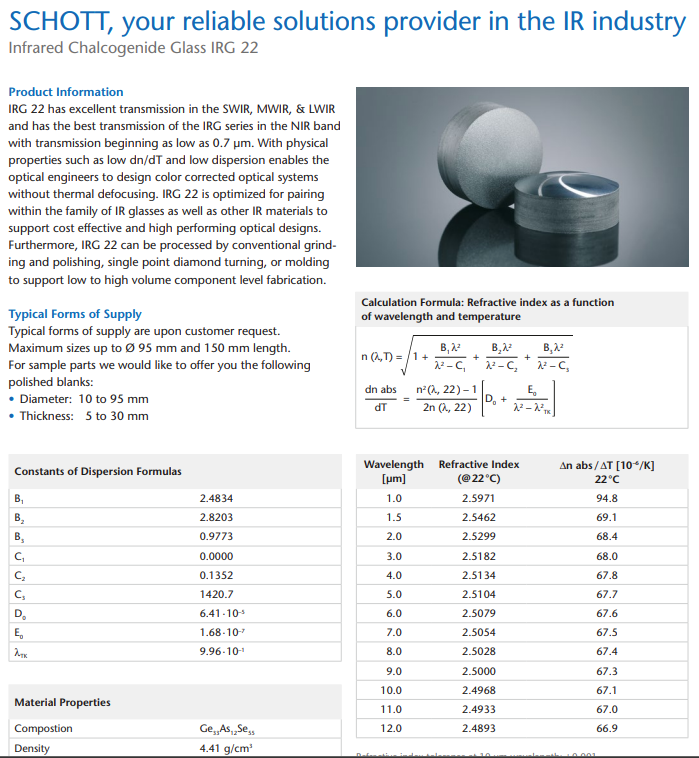Optical Windows
Optical windows are transparent components made of materials like glass or crystal that are used to protect and control the flow of light in optical systems. IR windows and optics for use in FTIR Spectroscopy and CO2 lasers. This includes discs, rectangular plates and various other geometries.
In various fields, optical windows serve many purposes. They act as protective barriers, shielding sensitive optical components from environmental factors such as dust, moisture, and contaminants. Additionally, they enable the transmission of light while minimizing distortion, reflection, and absorption, thus maintaining the integrity of the optical system.
Optical windows are employed in a wide range of applications, including scientific research, industrial manufacturing, aerospace, defense, and telecommunications. They are utilized in optical instruments like cameras, microscopes, telescopes, lasers, and sensors. By providing a stable optical interface, optical windows facilitate accurate measurements, imaging, and analysis of light, enabling advancements in numerous fields.
Optical windows come in many shapes and sizes but a major factor is their material. The types of materials that an optical window is constructed from dictate the wavelengths (measured in nm) that they can view. In IR It is extremely important that selecting the right material is done to avoid many a headache and a waste of money and time.
If you are having choice fatigue and are getting overwhelmed by all the options please check out our optical window guide.
AMTIR-1 (IRG 22) Windows
AMTIR-1 (IRG 22) Windows
AMTIR-1 (Amorphous Material Transmitting Infrared Radiation) is a chalcogenide glass window that has a transmission range of 750nm to 14μm, which covers all the way from the NIR into the midwave-IR range.
Featuring an excellent chemical resistance, especially to acids, AMTIR-1 is a common choice in caustic environments as protective windows. Whereas other IR materials like germanium are heat-sensitive, AMTIR-1 can be used with no coating up to 300ºC. Additionally, the lower index of refraction makes this material an ideal choice for using in FLIR (forward-looking infrared cameras and temperature measurement systems.
If you do not see the configuration that you are looking for please contact us at info@firebirdoptics.com for a custom quote.
AMTIR-1: The Superior Choice for IR Optical Windows
Optical windows are essential components in many optical systems, and they play a critical role in protecting sensitive optical elements from the environment. Choosing the right material for optical windows is crucial, as it can impact the overall performance of the system. One material that stands out as an excellent choice for optical windows is AMTIR-1. In this article, we will explore why AMTIR-1 is a better choice for optical windows than its alternatives.
What is AMTIR-1?
AMTIR-1 is a chalcogenide glass that contains arsenic, germanium, and sulfur. It has unique optical and mechanical properties that make it an ideal material for optical windows. AMTIR-1 is transparent in the mid-wave and long-wave infrared regions, with excellent transmission from 2 to 15 microns. It is also highly resistant to thermal shock, making it an excellent choice for applications that require high-temperature stability.
AMTIR-1 vs. Other Optical Window Materials
There are several materials that are commonly used for optical windows, including fused silica, sapphire, and zinc selenide. While each of these materials has its advantages, they also have limitations that make AMTIR-1 a better choice for some applications.
Fused silica is a popular choice for optical windows because of its excellent transmission from the ultraviolet to the near-infrared regions. However, it has limited transmission in the mid-wave and long-wave infrared regions, where AMTIR-1 excels. Fused silica is also brittle and can crack under thermal stress, making it unsuitable for high-temperature applications.
Sapphire is another popular choice for optical windows because of its excellent mechanical properties and high-temperature stability. However, sapphire is expensive and has limited transmission in the mid-wave and long-wave infrared regions. It is also prone to birefringence, which can affect the performance of optical systems.
Zinc selenide is a popular choice for mid-wave infrared applications because of its excellent transmission in this region. However, it is less transparent in the long-wave infrared region than AMTIR-1. Zinc selenide is also relatively soft and can scratch easily, making it unsuitable for applications that require high durability.
Advantages of AMTIR-1 for Optical Windows
AMTIR-1 has several advantages that make it a better choice for optical windows than other materials. Some of these advantages include:
Excellent transmission: AMTIR-1 has excellent transmission in the mid-wave and long-wave infrared regions, making it an ideal choice for applications that require high sensitivity in these regions.
High-temperature stability: AMTIR-1 is highly resistant to thermal shock, making it an excellent choice for high-temperature applications.
Durability: AMTIR-1 is harder than most other chalcogenide glasses, making it more durable and resistant to scratches.
Cost-effective: AMTIR-1 is a cost-effective alternative to sapphire for high-temperature applications.
Applications of AMTIR-1 Optical Windows
AMTIR-1 optical windows are used in a variety of applications, including:
Thermal imaging: AMTIR-1 is an ideal material for thermal imaging systems that require high sensitivity in the mid-wave and long-wave infrared regions.
Remote sensing: AMTIR-1 is used in remote sensing systems that require high sensitivity in the mid-wave and long-wave infrared regions.
Spectroscopy: AMTIR-1 is used in Fourier transform spectroscopy systems that require high sensitivity in the mid-wave and long-wave infrared regions.
AMTIR-1 (IRG 22) Specs:
Transmission of uncoated AMTIR-1 windows:
General specs:
| Wavelength range: 750nm-14µm | Coating: Uncoated |
|---|---|
| Diameter tolerance: ±0.2mm | Surface Quality: 60/40 |
| Thickness tolerance: ±0.1mm | Paralellism: <1 arc minute |
| Clear Aperture: 85% | Density: 4.41g/cm3 | Melting point: 368ºC | Young's Modulus: (GPa): 21.2 | Coefficient of Thermal Expansion: 12.5x 10-6/°C | Knoop Hardness: 170kg/mm2 | Chemical Composition: Ge33As12Se55 |
Index of Refraction:
| µm | No |
|---|---|
| 1.0 | 2.5971 |
| 5.0 | 2.5104 |
| 10.0 | 2.4968 |








Finding the right optical window can be an exercise in choice fatigue. Let us help!